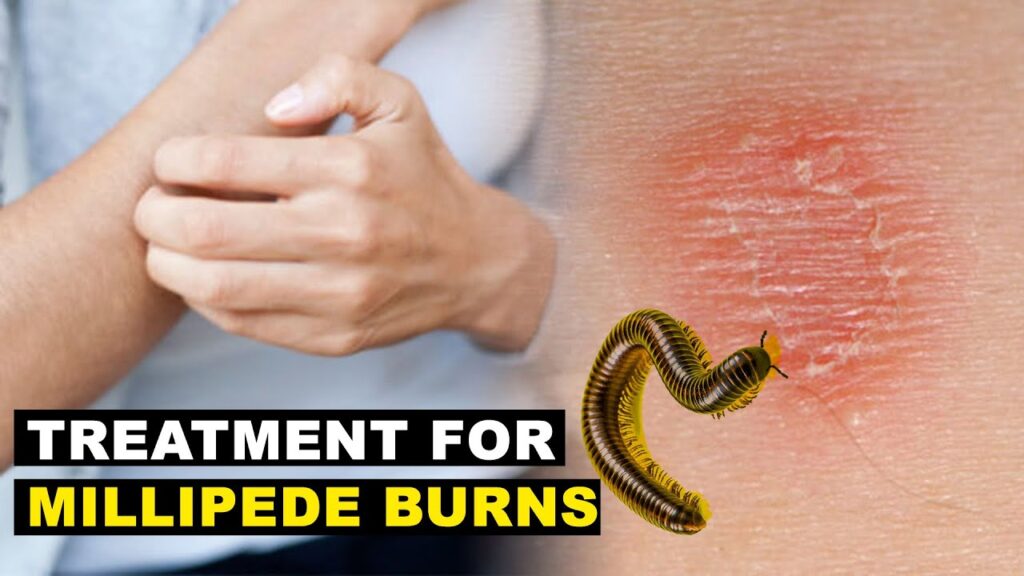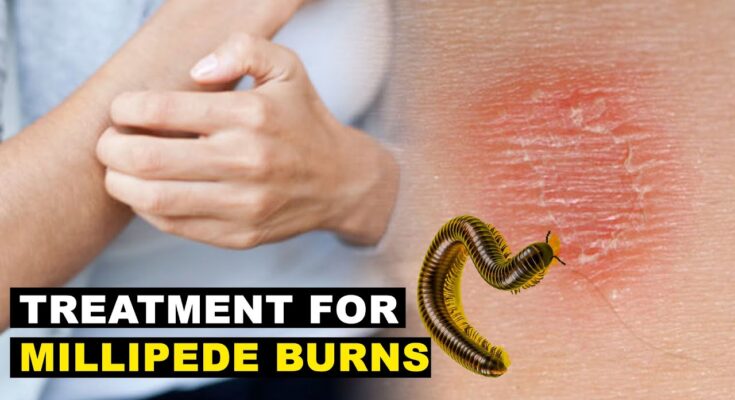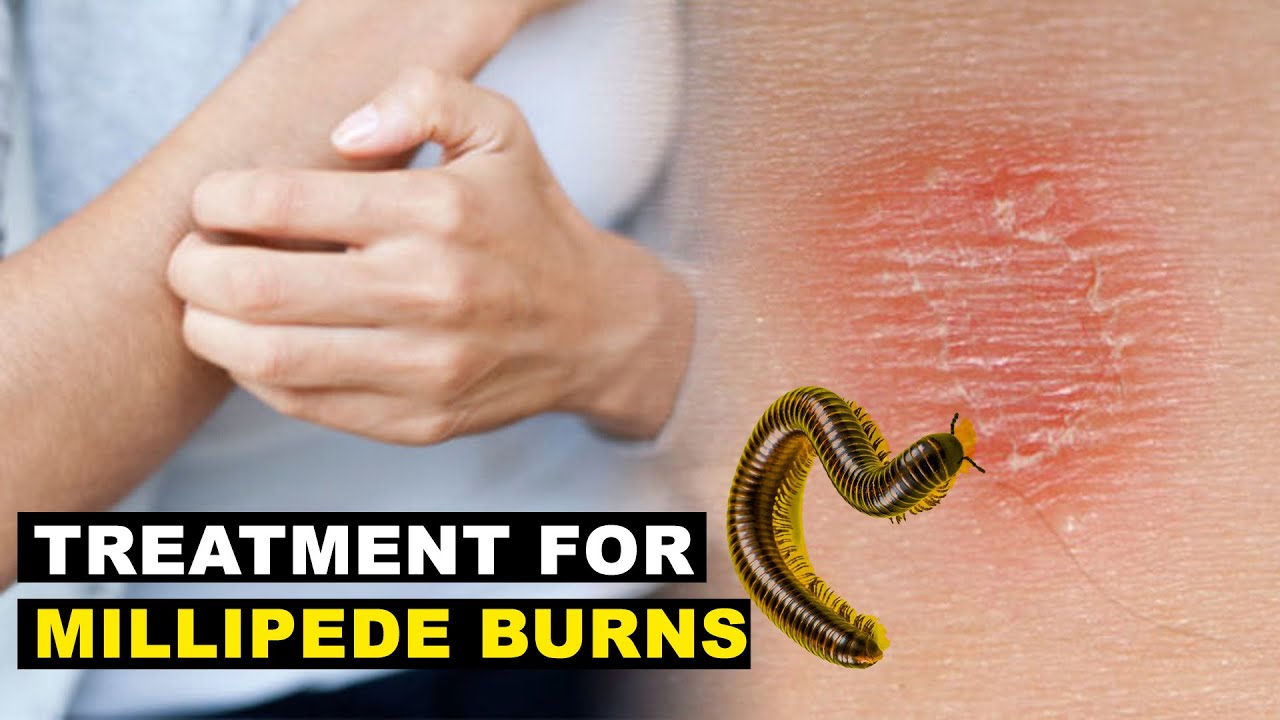Encountering wildlife is often a fascinating part of exploring the outdoors. However, sometimes these encounters can leave an unwelcome mark. If you’ve ever stumbled upon a millipede and experienced the unpleasant sensation often referred to as a “millipede burn,” you know it’s more than just a simple brush with nature. It’s a chemical irritation that requires proper care for healthy skin recovery.
But what exactly is happening to your skin, and what’s the best course of action to treat it? Forget generic advice; this post delves into the specifics, offering well-researched insights and practical steps to help you navigate the healing process effectively.
What Exactly Are Millipede “Burns”? It’s Not What You Think
The term “millipede burn” is a bit of a misnomer. Millipedes don’t produce heat or fire like a thermal burn. Instead, their defense mechanism involves secreting a liquid containing chemicals, primarily benzoquinones. These compounds are irritants designed to deter predators. Think of it less like a burn and more like a chemical defense spray.
When these secretions come into contact with human skin, they can cause a range of reactions. These include:
- Skin Discoloration: Often the most noticeable symptom, presenting as yellow, brown, or reddish patches. The color can be quite striking and persistent.
- Burning Sensation: A feeling of warmth or stinging at the contact site, which is where the “burn” term likely originates.
- Itching: Can range from mild to intense and can be one of the most bothersome symptoms.
- Inflammation: Redness and swelling around the contact area as your body reacts to the irritant.
- Blistering: In more severe cases, particularly with prolonged contact or in individuals with sensitive skin, blisters may form.
- Pain: While often described as a burning sensation, actual pain can also be present, especially if blistering occurs.
The severity of the reaction depends on several factors: the specific species of millipede (some produce more potent secretions than others), the amount of secretion that contacted the skin, the duration of contact, and your individual skin sensitivity and immune response. Understanding that it’s a chemical irritation, not a thermal burn, is the first step towards appropriate and healthy treatment. This distinction guides the type of first aid and subsequent care needed.
Immediate First Aid: Your Crucial First Steps
Time is of the essence when dealing with millipede secretions. Prompt action can significantly reduce the severity and duration of the reaction. Delaying first aid allows the chemicals more time to penetrate the skin and cause damage.
The absolute most critical first step is thorough washing. This is the cornerstone of initial treatment and cannot be stressed enough.
- Wash the affected area immediately and repeatedly with plenty of soap and water. Use a mild soap if possible to avoid further irritation. The goal is to dilute the secretions and physically remove them from the skin surface before they can cause more damage.
- Gentle scrubbing with a washcloth or soft brush can be helpful to dislodge any remaining secretions, but avoid harsh abrasion that could further damage the already irritated skin or break blisters if they are present.
- Rinse thoroughly under running water for several minutes to ensure all soap and residual secretions are gone. Repeat the washing process a couple of times if necessary, especially if the discoloration is significant.
If the secretions came into contact with your eyes, this is a medical emergency. Rinse your eyes immediately and continuously with copious amounts of clean water for at least 15-20 minutes. Hold your eyelids open while rinsing to ensure the water reaches all parts of the eye. Seek medical attention immediately after rinsing. Eye involvement can cause severe pain, inflammation, and potentially long-term damage if not treated promptly by a healthcare professional.
Contact with the mouth or ingestion of millipede secretions is also serious and requires immediate medical evaluation. Rinse the mouth thoroughly with water and contact poison control or seek medical help.
Treatment Options: A Comparison for Healthy Recovery
Once the initial washing is complete, you can explore various treatment options to manage symptoms and promote healthy skin healing. It’s helpful to compare different approaches to understand their benefits and limitations, allowing you to choose the most appropriate path for your situation.
Home Remedies: What Works and What to Approach with Caution
While the primary and most effective home remedy is the crucial initial washing, other suggestions sometimes surface. It’s important to distinguish between helpful practices and those that might be ineffective or even harmful.
- Continued Washing: Even after the initial first aid, continuing to gently wash the affected area daily with mild soap and water is a beneficial home practice. It helps keep the area clean and prevents secondary infection, which is important for healthy healing.
- Vinegar or Alcohol: Some older or anecdotal sources suggest applying weak acids like vinegar or alcohol might help neutralize the alkaline benzoquinones. The theory is that an acid might counteract the base. However, medical consensus on the effectiveness and safety of this is mixed. Applying acids or alcohol to already irritated, inflamed, or potentially blistered skin can cause significant pain, further damage, or chemical burns. There is limited strong scientific evidence supporting the widespread use of vinegar or alcohol for millipede secretions compared to the proven benefit of thorough washing and medically recommended treatments. Proceed with extreme caution and prioritize washing with soap and water. If you consider trying this, test a very small, unaffected area first and stop immediately if it causes increased burning or irritation.
- Cool Compresses: Applying cool, wet compresses can help soothe the burning sensation and reduce inflammation. Do not apply ice directly to the skin, as this can cause ice burns.
- Aloe Vera: While known for its soothing properties on thermal burns, the effectiveness of aloe vera on chemical irritations like millipede secretions is not specifically well-documented. It’s unlikely to be harmful for mild irritation after washing, but it’s not a primary recommended treatment.
Over-the-Counter Treatments: Targeted Relief
For managing symptoms like inflammation, itching, and pain, over-the-counter (OTC) options are often recommended and can be very effective in promoting comfortable and healthy recovery.
- Topical Corticosteroid Creams: Creams containing hydrocortisone (typically 0.5% or 1%) are widely available and are a primary treatment for the inflammation and itching caused by millipede secretions. These creams work by reducing the body’s inflammatory response. Apply a thin layer to the affected area a few times a day as directed on the product packaging. Using these can significantly improve comfort and reduce the urge to scratch, which is vital for preventing complications.
- Oral Antihistamines: If itching is significant, widespread, or interfering with sleep, taking an oral antihistamine can provide systemic relief. Medications like diphenhydramine (can cause drowsiness) or non-drowsy options like loratadine or cetirizine can help block the histamine response that contributes to itching.
- Pain Relievers: Over-the-counter pain relievers like ibuprofen (which also has anti-inflammatory properties) or acetaminophen can help manage any discomfort or pain associated with the irritation or blistering. Follow dosage instructions carefully.
Prescription Treatments: When OTC Isn’t Enough
In more severe cases, a doctor may prescribe stronger treatments:
- Prescription-Strength Topical Corticosteroids: For more intense inflammation or larger affected areas, a doctor might prescribe a stronger topical corticosteroid cream.
- Antibiotics: If blistering occurs and shows signs of secondary bacterial infection (e.g., increasing redness, swelling, warmth, pus, fever), oral antibiotics may be necessary to clear the infection and ensure healthy healing.
- Analgesics: Stronger pain medication might be prescribed for severe pain.
When to Seek Medical Attention: Don’t Hesitate
While most millipede “burns” can be managed at home with proper first aid and OTC treatments, certain situations warrant professional medical evaluation. Knowing when to seek help is crucial for preventing complications and ensuring the best possible outcome for your skin’s healthy recovery.
Seek medical attention if you experience:
- Severe Pain: Pain that is intense, persistent, and not relieved by OTC pain relievers.
- Extensive or Severe Blistering: Large or numerous blisters, blisters that cover a significant area, or blisters that appear deep or infected.
- Signs of Infection: Increasing redness spreading beyond the initial area, increased swelling, warmth, pus draining from blisters or the skin, or fever.
- Symptoms Affecting the Eyes or Mouth: As mentioned earlier, contact with these areas requires immediate medical attention due to the risk of serious damage.
- Symptoms That Worsen or Do Not Improve: If your symptoms are not getting better after a few days of consistent home care, or if they seem to be worsening despite treatment, consult a doctor.
- Signs of an Allergic Reaction: While less common from the chemical itself than from an insect sting, some individuals could potentially have an allergic response. Signs include difficulty breathing, swelling of the face, lips, or throat, a widespread rash or hives, dizziness, or a drop in blood pressure. These are signs of anaphylaxis and require immediate emergency medical care.
- If you are unsure: If you are concerned about the appearance of the reaction or are unsure about the best course of treatment, it’s always wise to consult a healthcare professional.
A healthcare professional can accurately assess the severity of the reaction, rule out other causes, prescribe stronger medications if needed (like prescription-strength corticosteroids or antibiotics for infection), and provide tailored guidance for optimal healthy healing based on your specific situation.
Key Insights for Healthy Skin Recovery
Beyond immediate treatment, focusing on promoting healthy skin recovery is crucial for minimizing long-term effects like scarring or persistent discoloration. The healing process takes time, and supporting your skin during this phase is vital.
- Keep the Area Clean: Continue to gently clean the affected area daily with mild soap and water. This simple step is fundamental in preventing secondary bacterial infection, which can delay healing and worsen scarring. Pat the area dry gently with a clean towel.
- Avoid Scratching: While itching can be intense due to the chemical irritation and the healing process, scratching is detrimental. Scratching can break the skin barrier, introduce bacteria, increase the risk of infection, and significantly worsen scarring and post-inflammatory hyperpigmentation (darkening of the skin). Use OTC treatments like corticosteroid creams and oral antihistamines to manage the itching effectively.
- Protect from the Sun: This is a critically important step for healthy long-term skin appearance after a millipede “burn.” Irritated or healing skin, especially areas that have experienced inflammation or blistering, are highly susceptible to hyperpigmentation when exposed to ultraviolet (UV) radiation from the sun. This can result in a dark brown or black stain that can last for many months or even years. Keep the affected area covered with clothing whenever possible. When covering is not feasible, apply a broad-spectrum sunscreen with a high SPF (30 or higher) generously and reapply frequently, especially after washing or sweating. Do this even on cloudy days, as UV rays can penetrate clouds. Continue sun protection until the skin color has completely returned to normal.
- Moisturize: Once the initial inflammation subsides and any blistering has resolved (and the skin is not weeping), keeping the skin well-moisturized can help support the natural healing process. Moisturizers help maintain the skin’s barrier function, reduce dryness, flaking, and itching, and can improve the overall texture of the healing skin. Use a gentle, fragrance-free moisturizer to avoid further irritation.
- Be Patient: Skin discoloration from millipede secretions is often the most prolonged symptom and can take weeks or even many months to completely fade. The exact duration varies from person to person. Be patient with the healing process and continue protective measures, particularly sun protection, consistently during this time. Trust that your skin is working to heal itself.
- Monitor for Changes: Keep an eye on the affected area for any signs of worsening symptoms, infection, or unusual changes. If you notice anything concerning, consult a healthcare professional.
Preventing Future Encounters
The best treatment is, of course, prevention. Avoiding contact with millipedes and their secretions is the most effective way to prevent a “burn.” Millipedes are generally harmless creatures that prefer dark, damp environments. They are not aggressive but will use their defense mechanism if they feel threatened or are handled roughly. To reduce your chances of an unwelcome encounter:
- Be cautious when handling logs, rocks, leaf litter, or soil, especially in damp areas. Millipedes often hide in these places.
- Wear gloves when gardening, landscaping, or working in areas where millipedes might be present.
- Inspect clothing or shoes that have been left outdoors before putting them on.
- Seal cracks and openings around your home to prevent millipedes and other pests from coming indoors.
- Reduce moisture around your home by fixing leaky pipes and ensuring good drainage, as millipedes are attracted to dampness.
Treatment Comparison at a Glance

Here’s a simple comparison of common treatment approaches to help you quickly assess your options for healthy recovery:
| Treatment Method | Primary Benefit | Considerations | When to Use |
|---|---|---|---|
| Immediate Washing | Removes irritant, reduces severity, prevents deeper penetration | Must be done immediately and thoroughly with soap and water. | Always the absolute first step after contact. |
| Topical Corticosteroids | Reduces inflammation, redness, itching | OTC options (hydrocortisone) are common; prescription may be needed for severe cases. Apply as directed. | For managing inflammation and itching after washing. |
| Oral Antihistamines | Reduces itching systemically | Can cause drowsiness (check product label); choose non-drowsy if needed during the day. | For significant or widespread itching. |
| Pain Relievers | Manages discomfort and pain | Follow dosage instructions; ibuprofen also helps with inflammation. | For managing pain or discomfort. |
| Vinegar/Alcohol | Potential neutralization (caution advised) | Effectiveness is debated; can cause significant pain or further irritation on damaged skin. | Use with extreme caution, if at all, after thorough washing. Not a primary recommendation. |
| Cool Compresses | Soothes burning sensation, reduces inflammation | Do not apply ice directly to the skin. | For immediate soothing relief after washing. |
| Sun Protection | Prevents hyperpigmentation, promotes even healing | Use high SPF broad-spectrum sunscreen or cover the area until color normal. | Crucial during the entire healing period, especially for discoloration. |
| Moisturizing | Supports skin barrier, reduces dryness/itching | Use gentle, fragrance-free products after initial inflammation/blistering subsides. | During the healing phase to support skin repair. |
| Medical Attention | Professional diagnosis and tailored treatment | Necessary for severe reactions, infection, eye involvement, persistent issues, or if unsure. | If symptoms are severe, worsening, or concerning; immediately for eye contact. |
A Personal Note on Healing
While I haven’t had a severe millipede “burn” myself, I’ve seen firsthand how frustrating persistent skin discoloration can be. A friend had a minor encounter while gardening, and the brownish stain lingered for nearly two months despite proper washing and care. It wasn’t painful after the first day, but the visible mark was a constant reminder. This experience reinforced the importance of protecting the area from the sun during the entire healing phase, even after the initial symptoms subside. It’s a small step, but a crucial one for promoting truly healthy skin recovery and minimizing visible reminders of the encounter. Patience and consistent care, particularly with sun protection, are key to achieving the best cosmetic outcome.
Conclusion
Experiencing a millipede “burn” is an unpleasant event, but understanding that it’s a chemical irritation allows for targeted and effective treatment. Immediate and thorough washing with soap and water is your most powerful tool in minimizing the initial impact. Following up with appropriate over-the-counter treatments for symptom management (like corticosteroid creams for inflammation and antihistamines for itching) can significantly improve comfort.
Crucially, focusing on healthy skin recovery practices like diligent sun protection to prevent hyperpigmentation and moisturizing to support the skin barrier are essential for minimizing long-term effects and achieving the best possible cosmetic outcome. Be patient with the healing process, as discoloration can take time to fade.
Remember, if your symptoms are severe, persistent, show signs of infection, or involve sensitive areas like the eyes, don’t hesitate to seek medical attention. A healthcare professional can provide the necessary care and guidance. Prioritizing proper care ensures your skin heals as quickly and completely as possible, leaving you free to enjoy the outdoors without lasting reminders of your millipede encounter.
What are your experiences with millipede “burns”? Do you have any tips for healthy skin recovery that have worked for you? Share your thoughts and questions in the comments below!







